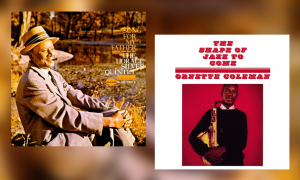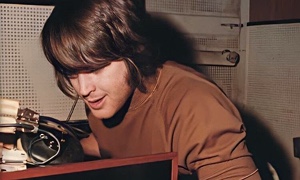Home » Jazz Articles » Building a Jazz Library » Bill Evans: Ten Essential Sideman Albums
Bill Evans: Ten Essential Sideman Albums

Courtesy Don Hunstein
Evans was choosy about who we worked with, even with a monkey the size of King Kong on his back. He always needed money. But he would not debase himself or his music for a quick buck.
Evans' hardcore fans include practically every musician who played with him. Eddie Gomez, his bassist for 11 years, spoke for many when, in an interview for the liner booklet of Bill Evans Treasures (Elemental, 2021), he said: "Every note was perfect. He was always amazing. There just isn't any bad stuff."
So good luck with selecting Evans' top sideman albums.
The exercise is made harder by the fact that from the outset Evans was choosy about who he worked with. His first studio date was in 1955 on clarinetist Artie Shaw wannabe Jerry Wald's Listen To The Music Of Jerry Wald (Kapp, 1956 ). Wald was not about breaking new ground but he had technique and a tangible passion for swing. (When Evans recorded with him, by the by, the sextet also included drummer Paul Motian, later to be a key figure in Evans' career.)
Evans was just as choosy a decade later when he had a monkey the size of King Kong on his back. He always needed money. But he would not debase himself or his music for a quick buck. After receiving trumpeter Miles Davis' imprimatur in 1958-59, every chancer in the business would have liked to get Evans on his session. It never happened.
Not included in this top ten but receiving honorary mentions are clarinetist Tony Scott's A Day In New York (Fresh Sound, recorded 1957, released 1991), Golden Moments and I'll Remember (both Muse, recorded 1959, released 1984), composer/arranger Michel Legrand's Legrand Jazz (Columbia, 1958), alto saxophonist Lee Konitz's Live At The Half Note (Verve, recorded 1959, released 1994), trumpeter Chet Baker's Chet (Riverside, 1959) and vibraphonist Dave Pike's Pike's Peak (Epic, 1962). Other contenders have been excluded because Evans is only present on one or two tracks.
Also excluded, Evans' two albums with singer Tony Bennett: The Tony Bennett/Bill Evans Album (Fantasy, 1975) and Together Again (Fantasy, 1977). Evans and Bennett were co-leaders on both.
In 1977, Evans told The New York Times: "I am a rather simple person with a limited talent and perhaps a limited perspective." All the evidence suggests he genuinely believed this. The depth of his talent and the breadth of his perspective is, however, conclusively proved by the variety of situations in which he excelled himself, not just when recording as a leader, but as a sideman, too.
Bill Evans: Ten Essential Sideman Albums
The albums are listed in chronological order of recording, not of release.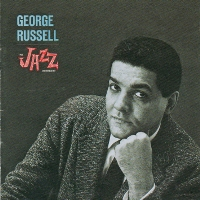 George Russell
George Russell The Jazz Workshop
RCA Victor
1957 (recorded 1956)
When Miles Davis was looking for a replacement for pianist Red Garland in early 1958, composer/arranger George Russell rang him to recommend Evans. In a 1998 interview, Russell told Evans' biographer, Peter Pettinger, that the conversation went like this:
"Is he white?" asked Miles.
"Yeah," I replied.
"Does he wear glasses?"
"Yeah."
"I know that motherfucker. I heard him at Birdland—he can play his ass off. Bring him over to the Colony Club in Brooklyn on Thursday night." (Russell duly drove Evans over; Evans did a hot-seat auditon; Davis offered him the job.)
Evans plays his ass off, and then some, on "Concerto For Billy The Kid" on Russell's calling card, The Jazz Workshop, recorded with a sextet which also included trumpeter Art Farmer and Paul Motian, both of whom we meet again below. Russell chose "Concerto For Billy The Kid" to close the album presumably because, despite the brilliance of the entire disc, nothing could follow Evans' high-voltage solo. It is a stomping tour de force which deserves to be played LOUD and will come like Christmas to anyone whose knowledge of Evans starts and ends with his later work.
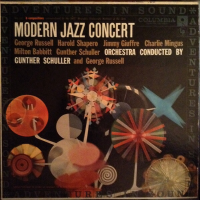 Jimmy Giuffre, Charles Mingus, George Russell
Jimmy Giuffre, Charles Mingus, George Russell Modern Jazz Concert
Columbia
1958 (recorded 1957)
Wherein Evans plays his ass off again. Modern Jazz Concert is a studio recreation of a performance at the 1957 Brandeis Jazz Festival by a 12-piece band conducted by composer/arranger Gunther Schuller. Brandeis had commissioned six compositions—three by "jazz" composers (George Russell, Charles Mingus, Jimmy Giuffre), three by "classical" ones (Schuller, Harold Shapero, Milton Babbitt). Collectively they were meant to blur the boundaries between jazz and classical music, as per the Third Stream school championed by Schuller.
The album as a whole is a bit of a curate's egg, but Russell's suite "All About Rosie" is among the keepers. The third movement is a platform for a rolling, tumbling Evans solo along similarly giddy lines as the one on "Concerto For Billy The Kid." Another notable Evans performance is his rousing gospel-infused work on Mingus' "Revelations" (which led to Evans appearing on the next album in this list).
Along with Russell's The Jazz Workshop and Evans' own-name debut, New Jazz Conceptions (Riverside, 1957), Modern Jazz Concert, though patchy, is one of a handful of albums which show off Evans' early, exhilarating, bop-based pianism to maximum advantage.
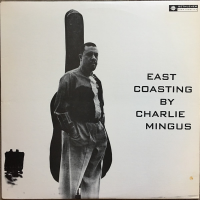 Charles Mingus
Charles MingusEast Coasting
Bethlehem
1957
The combination of Evans and composer/bassist Mingus may not necessarily suggest a marriage made in heaven, but
Evans was, almost literally, a last-minute inclusion. Around 4am on August 6, 1957, he received a wire asking if he could make a Mingus session at 10am (pianist Wade Legge being indisposed). Evans rose to the occasion as he always did. The album opens with Eubie Blake's poignant "Memories Of You." The theme is stated by Shaw's muted trumpet and followed by a lovely Evans solo spiced with unexpected but-just-exactly-right harmonic inversions. The remaining tracks are all Mingus originals, mostly mid-to-up-tempo hard boppers. Overall, compositionally, Tijuana Moods has the edge but Mingus was no slouch on East Coasting. Perhaps the most enduring piece is "Celia," a haunting tune dedicated to Mingus' wife (which he reprised with a larger lineup on Mingus Mingus Mingus Mingus Mingus on Impulse! in 1964). On it, Evans previews the block-chord technique which was soon to become part of his signature sound.
Mingus, impressed by Evans on the Brandeis project, was impressed once more and Evans became a member of Mingus' Jazz Workshop, staying for several months. A few months later Evans played on Knepper's A Swinging Introduction To Jimmy Knepper (Bethlehem, 1957), but, sadly, he did not record with Mingus again.
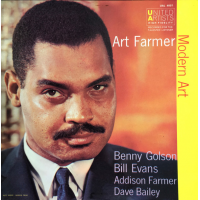 Art Farmer
Art Farmer Modern Art
United Artists
1958
Strictly speaking, the amiable Modern Art might not qualify as a sideman album. It had been planned by producer Jack Lewis as a showcase for three New Star winners of Downbeat magazine's 1958 International Critics' Poll—Evans, Farmer and tenor saxophonist Benny Golson—but ended up being released under Farmer's name. Dave Bailey is on drums and Farmer's brother Addison on bass. The album is a mix of ballads and hard boppers and includes two originals, Golson's pretty "Fair Weather" and Farmer's blues, "Moi Nix." As a soloist, Evans shines on "Fair Weather," Wade Legge's "Cold Breeze" (arranged by Gigi Gryce), Cole Porter's "I Love You," and Jimmy Van Heusen's "Like Someone In Love." Evans' comping is also to be savoured, notably the elegant funk he brings to Junior Mance's "Jubilation."
Earlier in 1958, in an interview with Nat Hentoff from which was pulled Miles Davis' "I've sure learned a lot from Bill Evans" soundbite for the cover of Everybody Digs Bills Evans (Riverside, 1959), Davis also said: "Like Red Garland, when [Evans] plays a chord, he plays a sound more than a chord only." Everybody Digs and Modern Art are glistening examples of Evans' emerging macro sound.
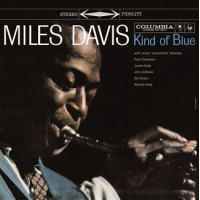 Miles Davis
Miles Davis Kind Of Blue
Columbia
1959
What more needs to be said about Kind Of Blue? What more usefully can be said about it?
Perhaps just this. Kind Of Blue is a bona fide Miles Davis masterpiece, no argument. But such was the degree of Evans' involvement that it could with some justification be attributed to "Miles Davis with Bill Evans." Evans wrote "Blue In Green," co-wrote "Flamenco Sketches" with Davis, and in Ashley Kahn's Kind Of Blue: The Making Of A Masterpiece (Da Capo, 2000), drummer and eyewitness Jimmy Cobb is quoted as saying: "A lot of [the album] was composed in conjunction with Bill Evans. The ideas and music were mostly where Bill was coming from." For good measure, Evans also wrote the liner notes, setting the disc in an extra- musical cultural context. Despite Evans' statements to the contrary, Davis always claimed sole credit for "Blue In Green" and "Flamenco Sketches." Joe Zawinul's "In A Silent Way" is the best known of several other pieces with similarly disputed attribution.
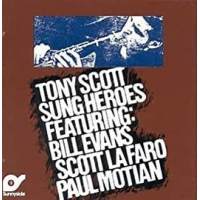 Tony Scott
Tony Scott Sung Heroes
Sunnyside
1986 (recorded 1959)
Evans began recording with Tony Scott in 1956 and the pair were good friends. Sung Heroes, recorded in October 1959, shortly before Scott took off on a two-year immersive tour of India and the Far East, is Evans and Scott's last recording together. More significantly, perhaps, it is the first known recording of Evans' fledgling trio with bassist Scott LaFaro and Paul Motian, who accompany Scott on three tracks: "Misery (To Lady Day)," "Requiem For Hot Lips Page" and "Blues For An African Friend." Evans' solo on "Misery" is one of his all-time best. On two other tracks, "For Stefan Wolpe" and "Israel," LaFaro and Motian drop out, leaving Evans the sole accompanist, while on "Remembrance Of Art Tatum," Scott takes over from Evans on piano.
Other recommended Scott/Evans albums include Golden Moments and I'll Remember, both recorded live at The Showplace in New York in August 1959 with bassist Jimmy Garrison and drummer Pete La Roca and released on Muse in 1984. Golden Moments' "My Melancholy Baby" includes an Evans solo of landmark proportions, built around two-hand parallel-octave lines, as musically exciting as it is technically accomplished. I'll Remember includes an off-the-wall fiery performance of "Stella By Starlight."
Also recommended, the double album A Day In New York (Fresh Sounds, 1991). Recorded in 1957, it is a collection of head arrangements of (mainly) standards featuring Scott, Evans and Motian and a rolling cast of horn players including trumpeter Clark Terry, Jimmy Knepper and alto saxophonist Sahib Shihab.
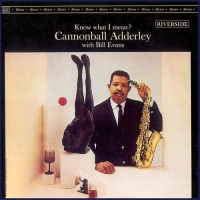 Cannonball Adderley
Cannonball Adderley Know What I Mean?
Riverside
1962 (recorded 1961)
In which alto saxophonist Cannonball Adderley proves himself to be as sure footed on ballads as he was on burners. He is assisted, immaculately, by Evans and Modern Jazz Quartet bassist Percy Heath and drummer Connie Kay. Adderley organised the sessions pretty much around Evans, even accommodating Evans' first-choice of piano by switching studios from Plaza Sound to Bell, where three weeks earlier Evans had recorded his trio album Explorations (Riverside, 1961). The disc opens with Evans' "Waltz For Debby," given its first full-length recorded workout, and includes Evans' choice of a second waltz, his friend Earl Zindars' "Elsa," which he had recorded for Explorations. The album closes with Evans' title track, a modal-based tune composed in the studio and referencing Evans and Adderley's time together in Miles Davis' sextet. Also heard to advantage are John Lewis' "Venice" and Jimmy Van Heusen's "Nancy (With The Laughing Face."
Evans played on two other Adderley albums, Portrait Of Cannonball (Riverside, 1958) and Jump For Joy (EmArcy, 1958) . Both are solid, but Know What I Mean? is more than that.
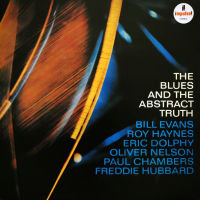 Oliver Nelson
Oliver Nelson The Blues And The Abstract Truth
Impulse!
1961
It has been suggested that Evans was miscast on composer/arranger/saxophonist Oliver Nelson's The Blues And The Abstract Truth, as the blues were not fundamental to his style. Miles Davis, it is true, had for that reason replaced Evans with Wynton Kelly for the 12-bar blues "Freddie Freeloader" on Kind Of Blues. But Evans was a master of blues-with-a-twist, as he had proved in his work with Charles Mingus, and expanding the blues form was exactly what Nelson was about on this, his follow-up to Screamin' The Blues (New Jazz, 1960). Far from being miscast, Evans was an inspired choice of pianist. The proof of that is shot through the album, from Evans' solo on the bittersweet opener, "Stolen Moments," through his empathetic comping behind flautist and alto saxophonist Eric Dolphy and trumpeter Freddie Hubbard on "Hoe-Down," his exalted soloing on "Cascades," written by Nelson as a showcase for Evans and Hubbard, on the delicate "Yearnin'" and also on the straight-up blues, the closer "Butch And Butch."
Producer Creed Taylor, who would figure large in Evans' subsequent work on Verve before he handed the producer baton to Helen Keane, was influential in involving Evans on another of Impulse!'s 1961 launch albums, trombonists J.J. Johnson and Kai Winding's The Great Kai & J.J. .
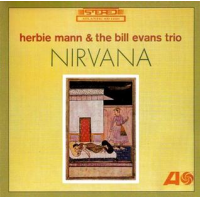 Herbie Mann & The Bill Evans Trio
Herbie Mann & The Bill Evans TrioNirvana
Atlantic
1964 (recorded 1961-62)
The importance of this album is considerable but it has little to do with the presence of flautist Herbie Mann. Nirvana is the first known recording of Evans' post-LaFaro trio with bassist Chuck Israels and Paul Motian, which would not return to the studio for close on six months.
Most of the tracks were recorded in December 1961, when Evans was still traumatised by LaFaro's death, and the new lineup is yet fully to mesh. But it is getting there. The weak link is Mann. His playing here is pretty but inconsequential and his writing ditto. The wafty title track (one of two Mann originals) is proto-New Age. So too the arrangement of Erik Satie's "Gymnopedies." The album finds its groove on three standards: an up-tempo reading of Cole Porter's "I Love You," a soulful version of Ann Ronell's "Willow Weep For Me" and, the highlight on the album on the strength of Evans' thoughtfully constructed solo, Jimmy Davis, Ram Ramirez and James Sherman's "Lover Man."
The closer is a second Mann original, "Cashmere." Given the cover art, the title is presumably intended as a nod to India's Kashmir region, the source of what is arguably the world's finest hashish. There is, unfortunately, not a whiff of it in the music.
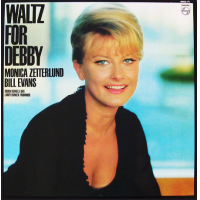 Monica Zetterlund
Monica Zetterlund Waltz For Debby
Philips
1964
Among the most charming items in Evans' discography, Waltz For Debby is nominally a back-up gig with Swedish singer Monica Zetterlund, recorded in Stockholm with Evans' shortlived trio with Chuck Israels and drummer Larry Bunker. It is delightful to hear four familiar treasures from Evans' repertoire—Harold Arlen and Johnny Mercer's "Come Rain Or Come Shine," Evans' "Waltz For Debby," and Leonard Bernstein, Betty Comden and Adolph Green's "Lucky To Be Me" and "Some Other Time"—performed with lyrics and arranged to suit Zetterlund's coolly innocent but alluring voice. "Waltz For Debby" is sung with Swedish lyrics by Beppe Wolgers (rather than the English language ones written by Evans' friend Gene Lees) and was retitled "Monicas Vals" for the occasion. Other tracks include Michel Legrand and Johnny Mercer's "Once Upon A Time," Jimmy van Heusen and Johnny Burke's "It Could Happen To You" and Harold Arlen and Dory Langdon's "So Long, Big Time!"
The YouTube clip below tells us volumes about how comfortably Evans and Zetterlund worked together, albeit that it shows a rehearsal for a TV performance recorded two years later in Copenhagen, on which Israels is replaced by Eddie Gomez and Bunker by Alex Riel.
Tags
PREVIOUS / NEXT
Support All About Jazz
 All About Jazz has been a pillar of jazz since 1995, championing it as an art form and, more importantly, supporting the musicians who make it. Our enduring commitment has made "AAJ" one of the most culturally important websites of its kind, read by hundreds of thousands of fans, musicians and industry figures every month.
All About Jazz has been a pillar of jazz since 1995, championing it as an art form and, more importantly, supporting the musicians who make it. Our enduring commitment has made "AAJ" one of the most culturally important websites of its kind, read by hundreds of thousands of fans, musicians and industry figures every month.










